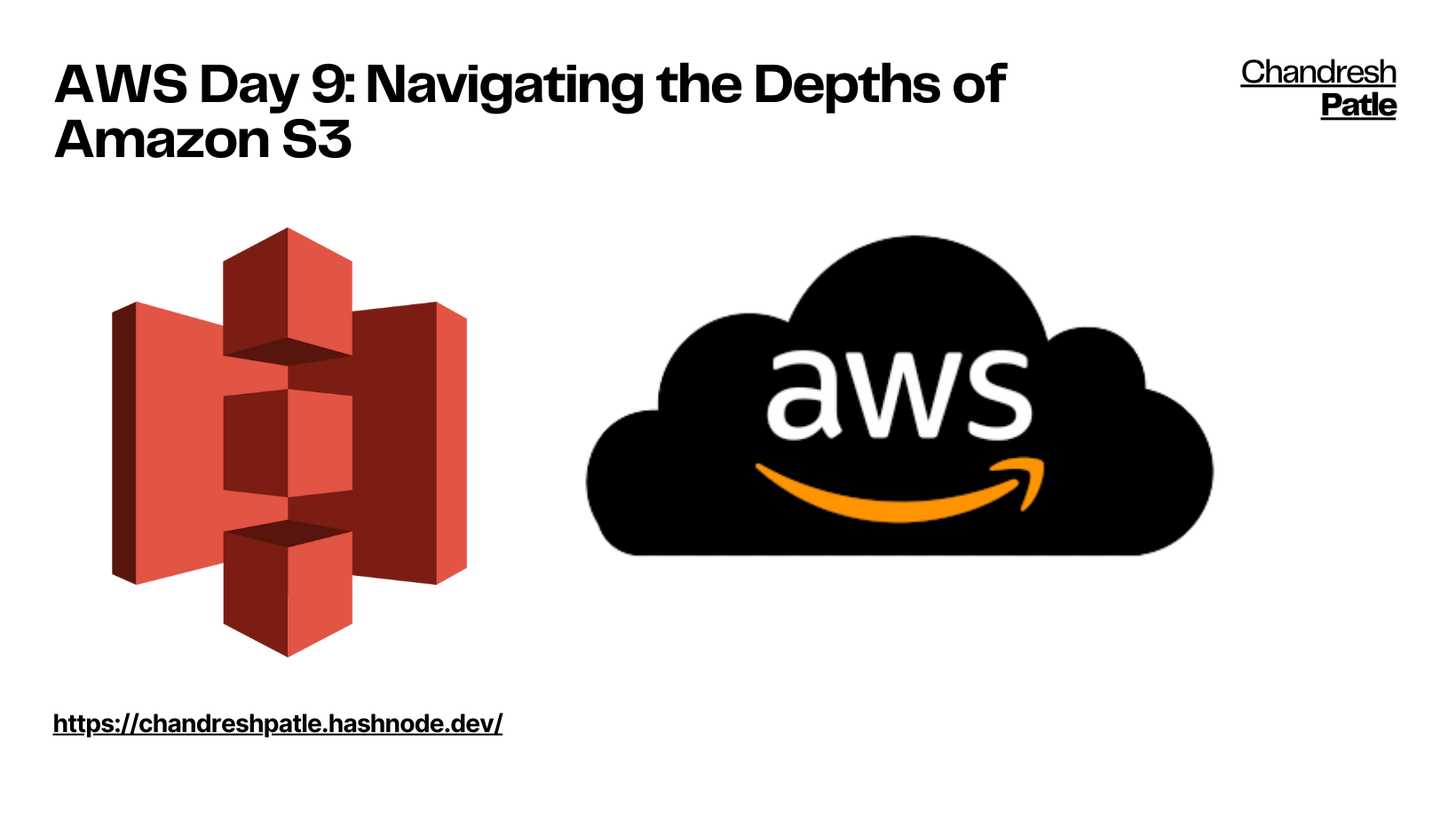AWS Day 9: Navigating the Depths of Amazon S3
 CHANDRESH PATLE
CHANDRESH PATLE
Welcome to Day 9 of your AWS journey! Today, we're embarking on a deep dive into Amazon Simple Storage Service (S3), one of the foundational services in AWS. In this blog post, we'll explore the intricacies of S3, from what it is and what it can store to its myriad benefits. We'll also embark on a practical journey, creating an S3 bucket, uploading an index.html file, and discussing access control with AWS Identity and Access Management (IAM) policies.
🔶 1. What is S3?
Amazon S3 is an object storage service that offers industry-leading scalability, durability, and performance. It's like a massive digital warehouse where you can securely store and retrieve data in the form of objects, such as files, images, videos, and more.
S3 is designed for a variety of use cases, including data backup and recovery, data archiving, website hosting, and data lakes for big data analytics.
🔶 2. What Can You Store in S3?
With S3, you can store a wide range of data types, including:
Files: Store documents, images, videos, and any digital file you can think of.
Databases: Use S3 as a data lake for your structured and unstructured data.
Backups: Store backups of your critical systems, ensuring data redundancy and availability.
Static Website Content: Host your static website assets, such as HTML, CSS, JavaScript, and media files.
Logs: Store log files generated by your applications for analysis and monitoring.
🔶 3. Benefits of S3
Amazon S3 offers a host of benefits:
Scalability: S3 scales automatically, accommodating your growing data without any manual intervention.
Durability: Data stored in S3 is redundantly stored across multiple devices and facilities, ensuring 99.999999999% (11 nines) durability.
Security: S3 provides robust security features, including access controls, encryption, and compliance certifications like GDPR and HIPAA.
Data Management: You can configure lifecycle policies to automatically transition or expire objects, optimizing cost and storage.
Versioning: S3 supports versioning, allowing you to preserve, retrieve, and restore every version of every object stored.
🔶 4. Creating an S3 Bucket and Access Control with IAM
Now, let's dive into a practical exercise to illustrate how S3 works with IAM access control:
Create an S3 Bucket:
Go to the AWS S3 console.
Click "Create bucket."
Follow the prompts to configure your bucket, including naming, region, and access control settings.
Upload an
index.htmlfile:Inside your newly created bucket, click "Upload."
Select your
index.htmlfile and follow the upload instructions.
IAM User Access Control:
Go to the AWS IAM console and create a new IAM user.
Attach the "AmazonS3FullAccess" policy to this user, providing them with full access to S3.
Access Control Example:
- Despite the admin's intention to block access to the S3 bucket, the IAM user with "AmazonS3FullAccess" will have full access to it, as their permissions override any bucket policy.
This example illustrates the importance of careful IAM user policy assignment and the hierarchy of access controls in AWS.
In conclusion, Amazon S3 is a versatile and powerful storage service offering numerous benefits, from scalability to security. Understanding how to create and manage S3 buckets and effectively control access through IAM policies is crucial for harnessing its full potential in your AWS projects.
As you continue your AWS journey, you'll find Amazon S3 to be an invaluable resource for your data storage and retrieval needs. Stay tuned for more AWS insights, hands-on guides, and best practices to enhance your AWS skills.
Happy exploring and storing data with Amazon S3!
🔶 Learning Resources:
Throughout my AWS journey, I've found valuable learning materials to enhance my understanding. One such resource that has been incredibly helpful is the YouTube playlist titled 'AWS Zero to Hero'
As I continue sharing my AWS experiences in this blog series, I encourage you to explore this playlist and stay curious about the ever-evolving world of AWS.
#AWS_Zero_to_Hero Repo: https://github.com/Chandreshpatle28/aws-devops-zero-to-hero.git
Happy Learning!
Stay in the loop with my latest insights and articles on cloud ☁️ and DevOps ♾️ by following me on Hashnode, LinkedIn (https://www.linkedin.com/in/chandreshpatle28/), and GitHub (https://github.com/Chandreshpatle28).
Thank you for reading! Your support means the world to me. Let's keep learning, growing, and making a positive impact in the tech world together.
#Git #Linux Devops #Devopscommunity #90daysofdevopschallenge #python #docker #Jenkins #Kubernetes #Terraform #AWS

Subscribe to my newsletter
Read articles from CHANDRESH PATLE directly inside your inbox. Subscribe to the newsletter, and don't miss out.
Written by